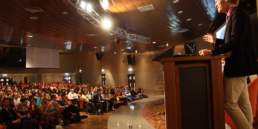20 years ago, in April 1992, the horrible war in Bosnia and Herzegovina started. AEGEE tried to help the students. This is the second of two articles that give an impression what we did. In September 1995, AEGEE-Europe President Egens van Iterson Scholten and I went to Tuzla to meet students who wanted to found AEGEE – three months before the war ended. Below you will find an article that I published a few days after the journey, with a small update from 1997.
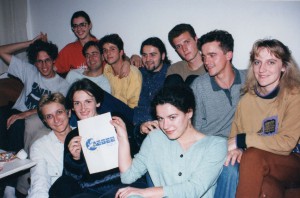
„Don’t worry.” Mirha did not even turn her head into the direction of the thunder of the cannons. „The fightings are 25 kilometers away.” Normal life in Tuzla on a rainy September day in Tuzla, September 1995. After four years of war the Bosnian student Mirha Becirovic and her friends could not be frightened so easily anymore. Not so their guests. The then AEGEE president Egens van Iterson Scholten and I were shocked by the „normality” of life.
Egens and I went to Tuzla in September 1995, because some students from Tuzla wanted to found an AEGEE contact. The Bosnian students heard about AEGEE by way of the Dutch „Youth support for former Yugoslavia” (YSY), who organise humanitarian aid and summer universities for students in Tuzla.
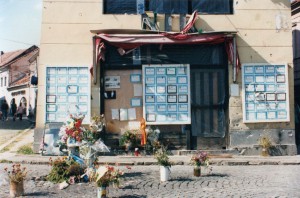
Travelling to Tuzla was not a dangerous adventure anymore at that time, three months before the Dayton agreement. But it was an experience in learning patience. From Zagreb to Tuzla regular buses went, but the time they needed was about 24 hours, depending on the traffic on the road quality, the weather, the number of border checks – and the frontline. The bus had to surpass the frontline and thus Tuzla – although only a few hundred kilometers away – became a very distant place.
Tuzla was full of refugees and displaced persons. During the war years doupled its population to about 150.000 people. But the city itself was not much harmed by the war. The biggest catastrophe that happened to the city occured in the end of May 1995, when a shell, fired by Bosnian Serbs, hit a square in the older part of the city. This place was popular meeting point for young people. At that afternoon 72 young people where on the square. All of them died. „I was thinking of going there as well on that afternoon”, remembers Dina, a student from Tuzla. Fresh flowers and nameplates with pictures of the victims were at one of the buildings on the square. „These two were close friends of mine”, saiy Dina and hints at two of the nameplates.
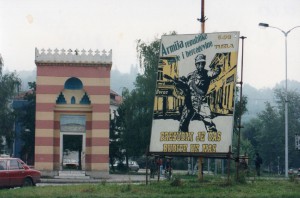
In the UN protection zone Tuzla the effects of the war could not be seen easily as in Sarajevo. One could see the soldiers on the street, spending a couple of free days in the city; many washed uniforms drying in the garden. UN cars where everywhere.
Despite the war there was no hunger catastrophy. The city was well supplied with food and other things by countless trucks. But if you wanted to take a shower you had to get up very early. Water worked only between 4 and 7 am and in the afternoon for a couple of hours. People had countless empty cola-bottles at home in which they filled water – for washing, cooking, the toilet. There was curfew in the city – no one was allowed to leave home after 10 pm. Night life did not exist, the students met at their places or took care that they were home by 10. Even worse student life was affected. The boys studied one month, the next month they went to the front. They had a different timetable from the girls.
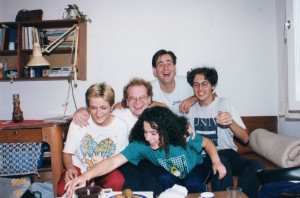
During our three-day-stay in Tuzla Egens and I tried to meet as many students as possible. YSY had already arranged a lot of meetings for us. All students we met were very interested in AEGEE. Most of them were already busy in own projects. Some of them wanted to organize computer courses and language courses and needed lecturers or experienced students from abroad. Other students wanted to organise books for their university library. We also met a student who wants to set up a students’ newspaper.
It was not difficult to bring these students together. AEGEE-Europe President Egens was the perfect person to explain, how AEGEE works. We also met with the rector and the vice-rector of the university. On the third day of their stay AEGEE-Tuzla was founded, when 12 students gathered in the dormitory, where most of the interested students live.
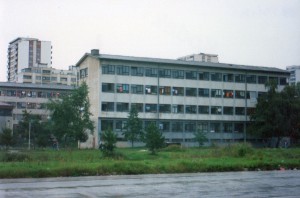
„AEGEE is a nice thing”, said Mirha. „Unfortunately it’s not so easy for us to travel”. Most students did not have passports, which cost 75 Euro at that time. They also needed an invitation from abroad, visa and a paper from the state that allows them to travel abroad. And they had to pay the travel expenses, which is hard to do for many students there.
Update 1997: Unfortunately AEGEE-Tuzla, although involved in the Case Study Trip Ex-Yugoslavia in 1996, is not doing very well. Most students are too busy with their own fate, so an international students organisation has only little importance. Still the AEGEE network is in contact with its friends in Tuzla. In summer 1996 and 1997 Dutch students went there in order to teach English and computer courses.
Gunnar Erth
Check out the photo album on Facebook
Read also: How AEGEE Helped Bosnian Students During the War
Related Posts
1st August 2019
The Gallery of All Presidents of AEGEE-Europe
Here is the gallery of all Presidents of AEGEE-Europe - with photos of every one of them. Enjoy the list!

